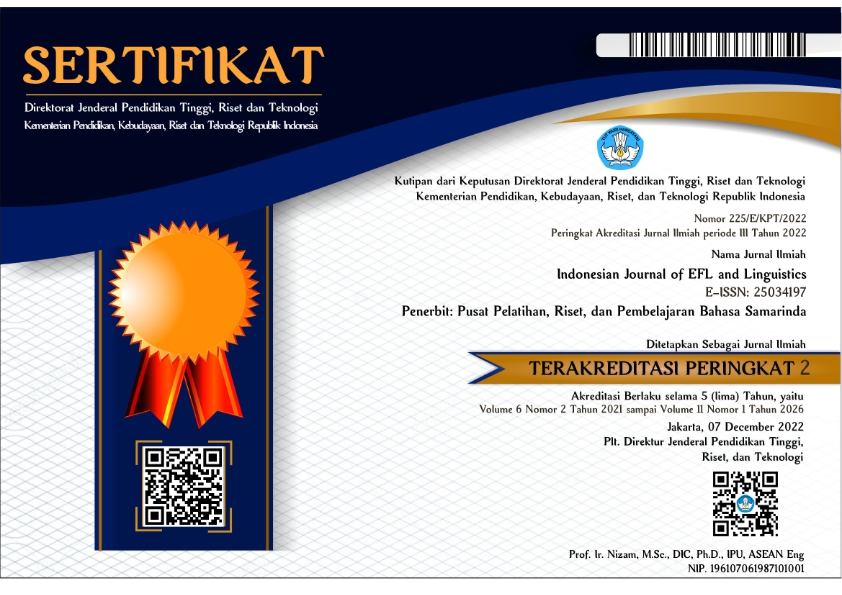Subjecthood in Banjarnese
Abstract
This research discusses the subject testing tools in the Banjar language. Subjecthood is one of the study materials within the scope of syntax. This research examines subject forms in the Banjar language using typological studies. Linguistic typology is one of the linguistic study theories and models founded on natural data and language structure systems. This research is descriptive qualitative research. This research data are clauses and sentences obtained in the direct speech of Banjar speakers. Respondents are Banjar individuals at least 18 years of age. They have a variety of genders, levels of education, native languages (L1), and places of residence. The study of the subjectivity of the Banjar language entails collecting data via multiple methods (observation and interview). The analysis method used in this research is the distributional method, followed by the advanced method. The result of this research states that the subjugation of the Banjar language follows the typology theory of subject testing. There are five types of subject testing tools applied in this research: canonical structure, relativization, control, adverbial insertion and reflexive. The use of typology theory can reveal the subject test tools.
References
Arka, I. W. (2003). Balinese Morphosyntax: A Lexical-Functional Approach. Pacific Linguistics, Research School of Pacific and Asian Studies, The ….
Basaria, I. (2018). Relasi Gramatikal Subjek Bahasa Pakpak Dairi: Kajian Tipologi. Talenta Conference Series: Local Wisdom, Social, and Arts (LWSA), 1(1), 49–58.
Blake, B. (2016). Relational Grammar. Routledge.
Budiarta, I. W. (2013). Tipologi Sintaksis Bahasa Kemak. Disertasi. Denpasar: Universitas Udayana.
Budiarta, I. W. (2016). Perilaku Subjek dalam Bahasa Kemak Kabupaten Belu Nusa Tenggara Timur. LITERA, 15(1).
Comrie, B. (1989). Language Universals And Linguistic Typology: Syntax And Morphology. University of Chicago press.
Comrie, B. (2017). Language Universals and Linguistic Typology: Syntax and Morphology. University of Chicago press.
Comrie, B., & Keenan, E. L. (1983). Noun Phrase Accessibility Revisited. Language, 55(3), 649. https://doi.org/10.2307/413321
Creswell, J. W. (2010). Research Design Pendekatan Kualitatif, Kuantitatif, dan Mixed. Yogyakarta: Pustaka Pelajar.
Culicover, P. W. (2017). Principles and Parameters: An Introduction to Syntactic Theory. Oxford University Press.
E., D., Foley, W. A., & Van Valin, R. D. (1986). Functional Syntax and Universal Grammar. The Modern Language Journal, 70(2), 192. https://doi.org/10.2307/327353
Fathonah, S., & Romadhan, A. D. (2021). Active and Passive Voice In Bulungan Language. Rainbow: Journal of Literature, Linguistics and Culture Studies, 10(2), 96–105.
Harahap, A. L. (2019). Kesubjekan Dalam Bahasa Batak Angkola: Ancangan Tipologi. Red: Revolution of English Department Journal, 3(2).
Harris, A. C., & Campbell, L. (2016). Historical Syntax in Cross-Linguistic Perspective (Issue 74). Cambridge University Press.
Jae, J. S. (2020). Tipologi Linguistik: Morfologi dan Sintaksis. Udayana University Press.
Ketut, A., & Jufrizal. (2018). Tipologi Linguistik: Konsep Dasar dan Aplikasinya. Pustaka Larasan.
Kridalaksana, H. (2017). Kamus Linguistik (Edisi Keempat). Gramedia Pustaka Utama.
Mahsun, M. S. (2005). Metode Penelitian Bahasa: Tahapan Strategi, Metode dan Tekniknya. PT RajaGrafindo Persada.
Mallinson, G., & Blake, B. J. (1981). Language typology: Cross-Linguistic Studies in Syntax. In North-Holland Publishing Company. North-Holland Publishing Company.
Manning, C. D. (2016). Voice and Grammatical Relations in Indonesian : A New Perspective Voice and Grammatical Relations in Indonesian : A New Perspective University of Sydney The University of Queensland , Brisbane Mirriam Butt and Tracy Holloway King ( Editors ). 4(June).
Palmer. (2016). Grammatical Roles and Relations. Cambridge University Press.
Romadhan, A. D. (2022). Subjek dan Oblik Bahasa Tidung. Cakrawala Linguista, 5(2), 70–78.
Romadhan, A. D., Hakim, L., Selia, A. K. W., Ekasani, K. A., Wuarlela, M., Hiariej, C., Janggo, W. O., Kami, P., Raja, F. D., & Susanti, R. (2023). Pengantar Linguistik Umum. CV. Intelektual Manifes Media.
Romadhan, A. D., & Sari, R. K. (2021). Subjecthood In Punan Tebunyau Language: Kesubjekan Bahasa Punan Tebunyau. Jurnal Kata: Penelitian Tentang Ilmu Bahasa Dan Sastra, 5(2), 224–234.
Shibatani, M., & Bynon, T. (2016). Approaches to Language Typology. Clarendon Press.
Shopen, T. (2018). Language Typology and Syntactic Description: Volume 3 (Vol. 3). Cambridge University Press.
Sudaryanto. (2017). Metode dan Aneka Teknik Analisis Bahasa. Sanata Dharma University Press.
Sugono, D. (1995). Pelesapan Subjek Bahasa Indonesia. Departemen Pendidikan dan Kebudayaan.
Verhaar. (2017). Pengantar Linguistik Umum. Gadjah Mada University Press.
Wouk, F., & Artawa, I. K. (2000). Ergativity and Balinese Syntax. Oceanic Linguistics, 39(1), 212. https://doi.org/10.2307/3623225
Zaim, M. (2014). Metode Penelitian Bahasa: Pendekatan Struktural. UNP Press.
Copyright (c) 2023 Indonesian Journal of EFL and Linguistics

This work is licensed under a Creative Commons Attribution-NonCommercial-ShareAlike 4.0 International License.




